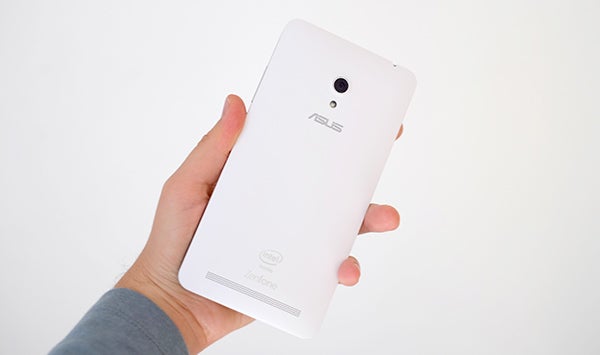Asus Zenfone 6 Review
Asus Zenfone 6 Review
A big phone with a not-that-big price

Sections
- Page 1 Asus Zenfone 6 Review
- Page 2 Screen Review
- Page 3 Software and Performance Review
- Page 4 Camera Review
- Page 5 Battery Life and Verdict Review
Verdict
Pros
- Giant screen great for video and gaming
- Decent performance
- Great battery life
Cons
- Relatively low-res, slightly soft screen
- Not small… obviously
- No 4G
Key Specifications
- Review Price: £249.00
- 6-inch 1,280 x 720 pixel IPS screen
- 16GB storage
- 2GB RAM
- 2GHz Intel Atom Z2580 CPU
First reviewed 16th September, 2014
What is the Asus Zenfone 6?
Sporting a 6-inch screen, the Asus Zenfone 6 is the largest model in Asus’s new range of Zenfones – a set of handsets out to bring Asus phones to a mainstream audience. This rather marked step up in price from the Zenfone 5 will get you a bigger screen, and both a better processor and camera.
Although the diminutive Zenfone 4 was a big disappointment we are big fans of the Zenfone 5, and it’s great value from just £119 SIM-free. The Zenfone 6 is a trickier proposition as its increased size introduces some usability issues, and at £250 without 4G it’s a pretty hefty investment. But it’s ultimately a solid phone, and a good deal if you don’t mind having a brand on your phone that your friends might turn their noses up at.
SEE ALSO: Best budget phones
Asus Zenfone 6 – Design
Packing a 6-inch screen, the Asus Zenfone 6 was always going to be a handful – You can’t build a phone with a 6-inch screen and make it small.
As the score suggests, we quite like the Zenfone 6. Unless you have gigantic hands though the size is something you need to take in to account before buying. In order to hold the handset in one hand you need to grasp it at the very edges of your fingertips, leaving little space to manoeuvre it unless you bring your second hand into the equation.

To limit the difficulties that arise from having such a large screen Asus could have trimmed the screen bezels down further, much like in the LG G3. Given its relatively recent beginnings in the mobile industry it’s difficult to be too harsh with Asus here, but sure enough the Zenfone 6 is sporting a width almost 6mm greater than the Galaxy Note 4. Yes, that phone has a slightly smaller 5.7-inch screen, but it’s one of the few genuinely desirable big-screen alternatives available.
Aside from the largely inescapable size issues (The Zenfone 6 also tops the scales at a rather hefty 196g) the Asus Zenfone 6 design is mostly a complete success. The look isn’t showy but has just enough little Asus inflections here to give the phone something bordering on an identity.
SEE ALSO: Best Android Phones

You
get a shiny bit of metal below the screen bearing a neat-looking finish
of concentric circles – an Asus signature – a small Asus logo on back
and front, and a simple, curved plastic rear.
In the Zenfone 5
we complained that the hardware soft keys looked a bit toy-like, a bit
too large. However – strangely enough – they’re actually a bit smaller
in this larger phone, giving them a more refined and sophisticated look.
The Zenfone 6’s design is not dynamic or particularly different. But from a company whose previous ‘phones’ like the Padfone 2 have been as ‘out there’ as the professor from Back to the Future, that’s no bad thing.

We
should also note that Asus has put some clear thought into making the
Zenfone 6 as usable as it can be. Where in the Zenfone 5 the power
button sits above the volume rocker, here it’s below, keeping it within
reach of your thumb. It’s hardly a eureka moment, but it’s reassuring.
Build
quality of the Zenfone 6 is commendable, even though the whole rear of
the phone is a fairly standard moulded piece of plastic. It feels tough,
there are no wide seams or creaky bits and the front of the phone is
covered with Gorilla Glass 3.
This is the kind of toughened
glass used in a great many high-end phones, and means you don’t really
need a screen protector unless you really want to sell it on in perfect
condition in a year or so. It’s highly scratch-resistant, and while it’s
used in quite a lot of lower-cost phones these days – even the Motorola Moto E – it’s good to see Asus managed to fit such a large pane of the stuff into the budget.

As
well as looking and feeling really rather good, the Zenfone 6 is also a
bit more flexible than an obvious rival on price, if not size: the
Nexus 5. There’s a microSD card slot under that back cover, which is a
great addition in a phone that really should be used as a little video
buddy. If that isn’t one of your primary considerations, why not get
something smaller?
There are 8GB, 16GB and 32GB versions of the
Zenfone 6 in existence, but the one we get in the UK at present has
16GB. There’s no 4G option at the moment, though. Given the £249 price,
this is an issue.
How we test phones
We test every mobile phone we review thoroughly. We use industry standard tests to compare features properly and we use the phone as our main device over the review period. We’ll always tell you what we find and we never, ever, accept money to review a product.



